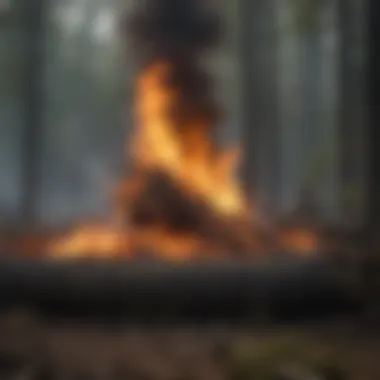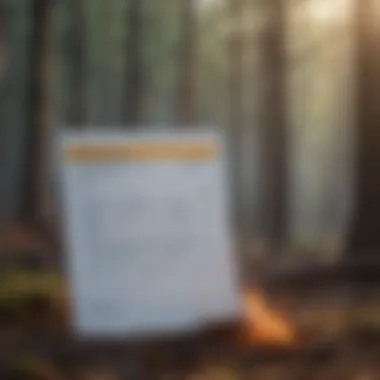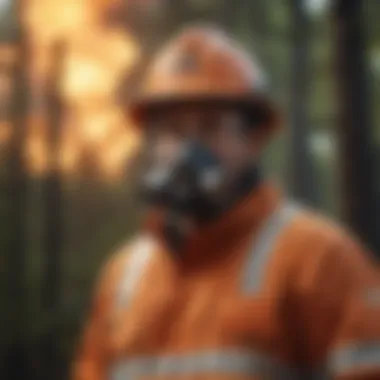Understanding Michigan DNR Burn Permits and Regulations


Intro
Burn permits in Michigan are more than just a piece of paper. They represent a critical intersection of environmental management, safety, and legal compliance. As residents and landowners aim to maintain their properties or clear out debris, it's crucial to understand the regulations set by the Michigan Department of Natural Resources (DNR). Ignoring the guidelines can lead not only to legal repercussions but also to detrimental effects on local ecosystems.
The application for a burn permit is not simply a box to check. It entails understanding the seasonal restrictions, the proper time to ignite, and the necessary precautions to ensure that the fire remains controlled. Michigan’s rich tapestry of forests, especially its evergreen species, requires careful stewardship. To engage in responsible land management, one must navigate this regulatory framework with care, recognizing it as a vital aspect of environmental conservation.
In the coming sections, we will delve into the intricacies of burn permits in Michigan. We will first examine the specific types of evergreen trees prevalent in the region, their ecological significance, and the conservation practices in place to protect them. Subsequently, we will discuss forest management techniques, the challenges posed by climate change, and the importance of preserving these natural landscapes. By synthesizing this information, we aim to provide a comprehensive understanding of Michigan DNR burn permits, highlighting their crucial role in maintaining the health of our forests.
Preamble to Michigan DNR Burn Permits
The subject of burn permits in Michigan plays a crucial role for various stakeholders, including landowners, environmentalists, and forestry professionals. This topic is not merely academic; it is about striking a balance between effective land management practices and the safeguarding of Michigan's diverse ecosystems. Understanding how the Michigan Department of Natural Resources (DNR) handles burn permits can shed light on key aspects ranging from legal compliance to environmental stewardship.
The role of the Michigan DNR
The Michigan DNR serves as the authority overseeing burn permits in the state, ensuring that burning practices align with policies designed to protect both public safety and natural resources. Their mandate encompasses educating the public about the importance of responsible burning, monitoring compliance with regulations, and enforcing penalties for unauthorized burns. Essentially, they act as guardians of the land, juggling multiple responsibilities that promote both land productivity and ecological health.
By granting these permits, the DNR not only streamlines the process for those wishing to manage their property or conduct agricultural burns but also works to mitigate the risks associated with uncontrolled fires. For seasoned professionals, collaboration with the DNR can enhance land management strategies, particularly in achieving specific objectives like habitat restoration or invasive species control.
What constitutes a burn permit?
A burn permit in Michigan is more than just a slip of paper – it serves as a formal agreement that stipulates when, where, and how burning activities can occur. Typically, these permits are necessary for open burning, allowing individuals to clear land or dispose of waste while complying with safety standards. The Michigan DNR outlines specific criteria that must be met for a burn permit to be issued:
- Purpose: Each permit must specify the reason for burning, be it for agricultural, forestry, or land management purposes.
- Timeframe: Permits usually include details about the acceptable burning duration, often aligned with seasonal considerations to prevent wildfire risks.
- Location: The permit indicates precise geographical coordinates, thus limiting burning to designated areas to safeguard surrounding properties and natural habitats.
- Safety Measures: Conditions may also incorporate safety protocols such as wind speed limitations and required firefighting equipment.
In essence, a burn permit encapsulates the regulatory framework while fostering responsible practices to ensure both public safety and environmental integrity.
Legal Framework of Burn Permits
The legal framework surrounding burn permits is crucial for maintaining safety and ecological sustainability in Michigan’s diverse landscapes. The Michigan Department of Natural Resources (DNR), through well-defined regulations, seeks to strike a balance between allowing necessary land management practices and ensuring public safety and environmental health. Understanding these regulations enriches the knowledge of forestry professionals and academics, ensuring that burning practices not only comply with the law but also contribute positively to natural ecosystems.
State regulations governing burn permits
In Michigan, state regulations are pivotal in dictating when and how burn permits can be issued. These rules are not just arbitrary but are formulated based on thorough research and experience regarding fire behavior, weather conditions, and the ecological impacts of fire. The DNR considers various factors, including:
- Local conditions: Geographic and climatological nuances play a big role. Areas prone to high winds or low humidity often face stricter rules due to increased fire risk.
- Time of year: In Michigan, there are specific times deemed safer for burning, primarily after the frost has lifted but before the summer dry season.
- Neighborhood considerations: Buffer zones may be established, especially in residential areas, to mitigate risks to nearby homes and property.
It’s essential for individuals applying for a burn permit to familiarize themselves with the specific regulations applicable in their county or township. Notably, Michigan has a public database accessible online where residents can check existing burn permits and current fire warnings. Ignorance of these regulations does not excuse individuals from repercussions if violations occur.
National fire laws and standards
On a broader scale, national fire laws and standards complement state regulations, creating a layered approach to fire management. The United States Forest Service and other federal agencies implement regulations that affect how fires can be managed across state lines. Under national frameworks, the following laws are significant:
- The National Environmental Policy Act (NEPA): This act mandates environmental considerations in federal land management decisions, including prescribed burning.
- The Clean Air Act: It sets forth provisions that impact the burning of certain materials, particularly those that may release harmful pollutants into the air.
Implementing these national standards alongside state regulations ensures a comprehensive assessment of increased fire activity's effects on air quality and public health. For practitioners, adhering to these wider laws is just as imperative as understanding local policies.


"Being informed is the first line of defense against environmental degradation and legal infractions. Educating oneself about the framework in which we operate is not just useful; it’s essential in today’s world."
Application Procedures for a Burn Permit
The application procedures for a burn permit in Michigan play a crucial role in ensuring that these permits are granted responsibly and safely. A proper application process safeguards the environment, helps prevent wildfires, and promotes compliance with regulations. Understanding these procedures offers a roadmap for individuals and businesses that need to burn debris or manage land effectively. Following the right steps can make all the difference in receiving a timely and approved burn permit, thus protecting your interests and those around you.
Where to apply for a burn permit
Applying for a burn permit in Michigan is straightforward if you know where to head. Generally, applicants should visit the Michigan Department of Natural Resources (DNR) website. This platform provides up-to-date information about available permits and specific guidelines tailored to various types of burning activities. Here, one can find useful links that redirect to local offices or a direct online application form.
For those who prefer face-to-face interaction, local DNR offices are the go-to place. Depending on where you’re located, it might mean a quick trip to a nearby office. Contacting the local office can also be beneficial in getting region-specific information about the burning season, health advisories, or any potential fire bans.
Step-by-step application process
The application process itself consists of several essential steps. Here’s a simple guide you can follow:
- Verify the Requirements: Before applying, check the local regulations concerning burn permits in your area.
- Visit the DNR Website: Access the online application form through the Michigan DNR website or contact your local office for guidance.
- Fill Out the Application: Provide accurate information about the intended burn area, type of materials to be burned, and the dates you plan to conduct the activity. Make sure every aspect is clear.
- Submit Your Application: Send in your application either online or in person. Make sure to keep copies of all submitted documents for your records.
- Wait for Approval: After submission, be prepared for a waiting period. The DNR will review your application and will get back to you with their decision. Remember that appropriate timing can play a big role in this step.
Required documentation
The documentation required during the application for a burn permit is vital. Having your paperwork in order can expedite the process considerably. Here are the common documents you might need:
- Identification: A valid state ID or driver's license can be required for verification.
- Detailed Burning Plan: This document explains the purpose, location, and nature of the burning activity, detailing what is being burned and why it’s necessary.
- Proof of Land Ownership: If applicable, documentation proving that you have the right to burn on the land in question.
- Local Fire Department Approval: In some cases, you might also need to obtain an opinion or signature from your local fire department, especially for large scale or residential burns.
Having all these documents handy not only smoothens the application process, but it also demonstrates your preparedness and commitment to following safety protocols.
"Understanding the application procedures fully not only ensures compliance with the law, but it also reflects a commitment to responsible land stewardship."
By familiarizing yourself with these application procedures, you effectively take the first steps towards responsible land management and fire safety in Michigan.
Types of Burn Permits Available
Understanding the different types of burn permits available is crucial for anyone considering an outdoor burning project in Michigan. Each permit serves a unique purpose and is tailored to specific needs, governing the methods and conditions permissible for burning. Clarity on this aspect is essential for responsible land management, as it directly impacts safety, legality, and environmental integrity.
Permits for residential burning
Residential burning permits cater primarily to homeowners. This type allows for the burning of yard debris—like leaves and small branches—under set regulations. When such permits are issued, homeowners can clear land without excessive buildup of combustible materials, which could pose a fire risk.
- Key considerations include:
- Time of year: Certain months may be more suitable for burning, considering humidity and winds that might carry sparks.
- Location factors: Understand proximity to structures and populated areas, which can influence risk levels.
- Types of materials: The burning of treated wood, plastics, and other hazardous materials is strictly prohibited.
Obtaining this permit ensures that homeowners not only comply with local rules but also engage in a community-oriented effort to manage yard waste responsibly.
Permits for agricultural burning
Agricultural burning permits are intended for farmers who may need to manage fields and pastures more efficiently. This includes burning off crop residue or clearing fields in preparation for new planting. Proper management through these permits can actually improve soil health and stimulate new growth in some cases.


- Important elements to consider:
- Purpose of burning: Ensure that the burning aligns with agricultural best practices and is necessary for crop management.
- Notification requirements: Some regions may require notifying neighbors or local authorities prior to burning.
- Timing and weather conditions: Farmers must monitor conditions, as dry or windy days can increase the risk of fire spreading beyond control.
In essence, these permits help streamline agricultural practices while aligning with sustainability efforts and community safety precautions.
Permits for forestry and land management
For those involved in forestry and land management, specific permits allow for prescribed burns aimed at enhancing the health of woodland and natural habitats. These controlled burns can help restore ecosystems, reduce competition for resources among plant species, and enable better wildlife habitats.
- Elements of these permits often include:
- Management objectives: Clear goals for what the burn aims to achieve (e.g., pest control or habitat restoration).
- Professional oversight: Many jurisdictions require that burns be conducted or supervised by certified personnel to mitigate risks.
- Regulatory compliance: Land managers must adhere closely to guidelines established by the Michigan DNR to prevent ecological damage or wildfire incidents.
In summary, understanding these types of burn permits is not merely about fulfilling regulations; it’s about ensuring that one engages in responsible stewardship of land, whether it be urban, agricultural, or forested. Each category of permit is designed not only for safety but also to promote sustainable practices that benefit both the community and the environment.
Safety Regulations Associated with Burn Permits
Understanding the safety regulations surrounding burn permits is vital for anyone looking to engage in burning practices, particularly in Michigan where strict guidelines are in place. These regulations are not mere formalities; they are designed to protect not just the environment but also the safety of individuals and communities. One misstep can lead to disastrous results, so being well-versed in these regulations is imperative for forestry professionals and land managers alike.
General Safety Guidelines
A handful of general safety guidelines serve as the foundation for responsible burning practices. First and foremost, it's crucial to understand the specific requirements associated with the type of burn you plan to conduct. Different permits often have unique stipulations based on environmental conditions. Here are several guidelines to keep in mind:
- Always check the local regulations and requirements for burn permits. They can vary significantly from one region to another.
- Wear appropriate protective gear, such as gloves, masks, and eye protection.
- Ensure that fire suppression materials, like water hoses or shovels, are readily available at the burn site.
- Inform neighbors and local authorities about the burn, particularly if it's a large operation. Communication is key.
- Never leave a fire unattended. The moment you take your eyes off it could lead to unforeseen escalations.
- Start your burn early in the day when humidity is typically higher and winds calmer. This minimizes risk.
"A controlled burn is only as safe as the preparation that precedes it."
Fire Weather Conditions and Forecasts
Monitoring fire weather conditions is not just advisable; it’s essential. Weather has a direct impact on how a controlled burn behaves. Before conducting any burning activities, you must assess the following factors:
- Wind speed and direction: High winds can carry embers beyond your intended area, igniting unwanted fires.
- Temperature: Warm, dry conditions can lead to rapid fire spread.
- Humidity levels: Low humidity can facilitate ignition. The ideal humidity for a burn is between 40% to 60%.
- Recent precipitation: A long dry spell can dry out vegetation, making it more receptive to ignition.
Utilizing tools like the National Weather Service forecast can help determine optimal weather conditions for burning. Engaging in a controlled burn when conditions are less favorable could lead to extensive harm, both financially and ecologically.
Through the adherence to defined safety regulations and an awareness of fire weather conditions, individuals can mitigate risks while effectively utilizing burn permits. Education on these factors ensures not only compliance with state laws but also the protection of Michigan's essential natural resources.
Understanding the Environmental Impact
Understanding the environmental impact of burn permits is crucial in assessing how these activities influence Michigan's natural ecosystems. Controlled burns are not merely a method of land management—they're a management tool that, when applied carefully and knowledgeably, can enhance the health of the environment. The relationship between fire and ecology is intricate; while wildfires can devastate ecosystems, controlled burns can prevent more severe fires by reducing fuel loads, which in turn preserves habitats and maintains species diversity.
Ecosystem effects of controlled burns
Controlled burns play a significant role in shaping ecosystems. When executed under the right conditions, they can mimic the natural fire cycles that many ecosystems have evolved with. For instance:


- Nutrient Cycling: Fires return nutrients to the soil. Ash adds potassium, phosphorus, and other trace elements that are important for plant health—essentially rejuvenating the land.
- Species Composition: Some plant species are fire-adapted, meaning their seeds require the heat from fire to germinate. In Michigan, species like certain pines thrive post-burn, which helps maintain diverse plant communities.
- Habitat Improvement: Burned areas can encourage the growth of shrubs and young trees, providing habitats for various wildlife. This shift aids in creating a mosaic of different ecosystem types, which increases habitat variety.
Its not uncommon for those in forestry to observe that some areas after controlled burning show exuberant signs of life, with a variety of plants and animals coming back stronger than before. Hence, in ecological terms, controlled burns are a bit like a reset button, promoting diversity and resilience in the landscape.
Impact on wildlife and biodiversity
The impact of controlled burns on wildlife is a double-edged sword. On one side, it can be disruptive; but on the flip side, the benefits often outweigh the negatives for many species. In short:
- Habitat Creation: Many animals depend on the succession of plant life that follows a burn. For instance, rabbits and deer often thrive in areas where underbrush is cleared post-burn, providing easy access to food.
- Increased Food Availability: Post-burn environments tend to have a surge in younger, nutrient-rich plants that attract herbivores, which in turn attracts predators. This cycle can enhance food webs based on local ecosystems.
- Long-Term Population Viability: Species populations can stabilize long-term when their habitat is maintained by regular controlled burns. Ground-nesting birds, for example, benefit from the reduced tall grass and brush that result from burning, making it easier for them to forage and raise their young.
Overall, the environmental impacts of burn permits are a critical consideration in the conservation and management strategies employed by the Michigan DNR. By recognizing the nuanced relationship between fire and the environment, stakeholders and land managers can make informed decisions that support not just fire management but holistic ecosystem stewardship.
Monitoring and Compliance
Monitoring and compliance are fundamental pillars ensuring the effectiveness and integrity of the burn permit system within Michigan. This section looks closely at how adherence to rules impacts not only individual land managers but also the broader community and environment. Understanding compliance isn't merely about avoiding penalties; it's about fostering responsible practices that benefit everyone.
Role of the Michigan DNR in monitoring
The Michigan Department of Natural Resources plays a crucial role in overseeing burn permits. Their responsibilities extend far beyond issuing permits; they monitor compliance, assess environmental conditions, and enforce regulations. The DNR employs various methods to keep tabs on burn activities, which include:
- Field Inspections: DNR officials often conduct inspections to observe burn operations first-hand, ensuring adherence to safety standards and environmental regulations.
- Community Reporting: Citizens can report concerns or irregularities surrounding burn activities. This community involvement enhances the monitoring process by acting as an additional set of eyes in the field.
- Compliance Training: By providing resources and workshops, the DNR educates permit holders about their responsibilities, fostering a culture of compliance.
Such monitoring not only helps in mitigating risks but also supports sustainable land management practices that align with ecological goals. The proactive engagement of the DNR ensures that permit holders are well-informed and meet both legal and environmental expectations.
Consequences of non-compliance
Falling short of compliance can lead to several ramifications, both for individuals and the state’s environment. Ignoring the rules established by the DNR carries consequences that could prove costly. The potential outcomes of non-compliance include:
- Fines and Legal Action: Individuals or organizations failing to secure the proper permits or adhering to regulations may face monetary penalties. In more serious cases, legal actions could be taken.
- Environmental Damage: Non-compliance can lead to unintended fires that may endanger wildlife habitats, destroy vegetation, and disrupt ecosystems. The long-term effects of such damage are hard to estimate and can end up harming the very landscape that landowners seek to manage.
- Reputational Consequences: For forestry professionals and land managers, non-compliance can tarnish reputations, leading to a loss of trust among stakeholders and the public. Adhering to regulations highlights a commitment to responsible land management.
In short, the stakes of overlooking the compliance requirements are not just personal but can have far-reaching consequences for the environment, community well-being, and professional integrity.
"Regulations might seem burdensome, but they serve a purpose: protecting our shared natural heritage for future generations."
In the end, monitoring and compliance are not just administrative tasks; they are vital to ensuring that burn activities contribute positively to Michigan's landscape and ecological integrity.
End
Understanding the nuances of burn permits issued by the Michigan Department of Natural Resources (DNR) holds a crucial position for land management and environmental stewardship. As we reflect on the information distilled throughout this article, several key elements emerge, emphasizing the relevance and criticality of these permits.
Summary of key points
Burn permits play a vital role not just in controlling fire hazards but also in promoting ecosystem health. From the initial application process to the monitoring and compliance stages, each aspect is intertwined with safety regulations and environmental considerations. Key points include:
- Legal Framework: Clear laws ensure responsible fire usage, minimizing risks.
- Application Procedures: Knowing where and how to apply streamlines the process for landowners and professionals alike.
- Types of Permits: Different permits cater to specific needs, whether for residential, agricultural, or forestry purposes.
- Safety Guidelines: Awareness of weather conditions and fire management techniques underpins safe practices.
- Environmental Impact: Controlled burns foster a balanced ecosystem and support wildlife habitats.
By understanding the requirements and responsibilities that accompany these permits, individuals and organizations can significantly contribute to preserving Michigan’s natural resources.
The future of burn permits in Michigan
Looking ahead, the future of burn permits in Michigan appears to invite new challenges and opportunities. As climate patterns shift and ecosystems evolve, the Michigan DNR’s regulatory framework must adapt accordingly. Here are some emerging considerations:
- Increased awareness of climate change effects, necessitating more flexible regulations to allow for varied fire management tactics.
- Enhanced technology and real-time data systems could streamline the application and monitoring processes.
- Greater emphasis on community education, encouraging best practices and environmental mindfulness.
- Collaboration with local communities and stakeholders to ensure that fire practices are both sustainable and culturally sensitive.



